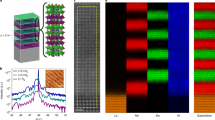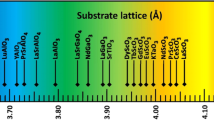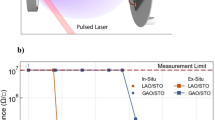Abstract
Interfaces between different materials underpin both new scientific phenomena, such as the emergent behaviour at oxide interfaces, and key technologies, such as that of the transistor. Control of the interfaces between materials with the same crystal structures but different chemical compositions is possible in many materials classes, but less progress has been made for oxide materials with different crystal structures. We show that dynamical self-organization during growth can create a coherent interface between the perovskite and fluorite oxide structures, which are based on different structural motifs, if an appropriate choice of cations is made to enable this restructuring. The integration of calculation with experimental observation reveals that the interface differs from both the bulk components and identifies the chemical bonding requirements to connect distinct oxide structures.
This is a preview of subscription content, access via your institution
Access options
Subscribe to this journal
Receive 12 print issues and online access
$259.00 per year
only $21.58 per issue
Buy this article
- Purchase on Springer Link
- Instant access to full article PDF
Prices may be subject to local taxes which are calculated during checkout




Similar content being viewed by others
References
Kroemer, H. Nobel Lecture. Quasielectric fields and band offsets: teaching electrons new tricks. Rev. Mod. Phys. 73, 783–793 (2001).
Chambers, S. A. Stability at the surface. Science 346, 1186–1187 (2014).
Douglas, J. P. Si/SiGe heterostructures: from material and physics to devices and circuits. Semicond. Sci. Tech. 19, R75–R108 (2004).
Jain, S. C., Willander, M., Narayan, J. & Overstraeten, R. V. III–Nitrides: growth, characterization, and properties. J. Appl. Phys. 87, 965–1006 (2000).
Chakhalian, J., Millis, A. J. & Rondinelli, J. Whither the oxide interface. Nature Mater. 11, 92–94 (2012).
Ohtomo, A. & Hwang, H. Y. A high-mobility electron gas at the LaAlO3/SrTiO3 heterointerface. Nature 427, 423–426 (2004).
Tsukazaki, A. et al. Quantum Hall effect in polar oxide heterostructures. Science 315, 1388–1391 (2007).
Kozuka, Y. et al. Two-dimensional normal-state quantum oscillations in a superconducting heterostructure. Nature 462, 487–490 (2009).
Demkov, A. A. & Posadas, A. B. Integration of Functional Oxides with Semiconductors 1st edn (Springer-Verlag, 2014).
Bauer, E. & van der Merwe, J. H. Structure and growth of crystalline superlattices: from monolayer to superlattice. Phys. Rev. B 33, 3657–3671 (1986).
Shih, H.-Y. et al. Ultralow threading dislocation density in GaN epilayer on near-strain-free GaN compliant buffer layer and its applications in hetero-epitaxial LEDs. Sci. Rep. 5, 13671 (2015).
Bollmann, W. Crystal Defects and Crystalline Interfaces (Springer-Verlag, 1970).
Erwin, S. C., Gao, C., Roder, C., Lähnemann, J. & Brandt, O. Epitaxial interfaces between crystallographically mismatched materials. Phys. Rev. Lett. 107, 026102 (2011).
Benedek, R., Seidman, D. N. & Woodward, C. The effect of misfit on heterophase interface energies. J. Phys. A 14, 2877 (2002).
Chen, Y. Z. et al. A high-mobility two-dimensional electron gas at the spinel/perovskite interface of γ-Al2O3/SrTiO3 . Nature Commun. 4, 1371 (2013).
Prasad, B. D. et al. Effect of substrate materials on laser deposited Nd1.85Ce0.15CuO4−y films. J. Mater. Res. 9, 1376–1383 (1994).
Nie, Y. F. et al. Atomically precise interfaces from non-stoichiometric deposition. Nature Commun. 5, 4530 (2014).
Yan, L. et al. Unit-cell-level assembly of metastable transition-metal oxides by pulsed-laser deposition. Angew. Chem. Int. Ed. 46, 4539–4542 (2007).
Nakagawa, N., Hwang, H. Y. & Muller, D. A. Why some interfaces cannot be sharp. Nature Mater. 5, 204–209 (2006).
Cavallaro, A. et al. Electronic nature of the enhanced conductivity in YSZ–STO multilayers deposited by PLD. Solid State Ionics 181, 592–601 (2010).
Garcia-Barriocanal, J. et al. Colossal ionic conductivity at interfaces of epitaxial ZrO2:Y2O3/SrTiO3 heterostructures. Science 321, 676–680 (2008).
Pennycook, T. J. et al. Seeing oxygen disorder in YSZ/SrTiO3 colossal ionic conductor heterostructures using EELS. Eur. Phys. J. Appl. Phys. 54, 33507 (2011).
Mitchell, R. H. Perovskites: Modern and Ancient (Almaz Press, 2002).
Tilley, R. J. D. Crystals and Crystal Structures (Wiley, 2006).
Cavallaro, A., Ballesteros, B., Bachelet, R. & Santiso, J. Heteroepitaxial orientation control of YSZ thin films by selective growth on SrO-, TiO2-terminated SrTiO3 crystal surfaces. CrystEngComm 13, 1625–1631 (2011).
Pergolesi, D., Fronzi, M., Fabbri, E., Tebano, A. & Traversa, E. Growth mechanisms of ceria- and zirconia-based epitaxial thin films and hetero-structures grown by pulsed laser deposition. Mater. Renew. Sustain. Energy 2, 6 (2013).
Inoue, T., Morimoto, T., Kaneko, S., Horii, Y. & Ohki, Y. Crystalline structures of YAlO3 single crystal at high temperatures. Proceedings of 2014 International Symposium on Electrical Insulating Materials (ISEIM) 208–211 (Institute of Electrical Engineers Japan, 2014).
Payne, J. L., Tucker, M. G. & Evans, I. R. From fluorite to pyrochlore: characterisation of local and average structure of neodymium zirconate, Nd2Zr2O7 . J. Solid State Chem. 205, 29–34 (2013).
Wang, Z. L. & Shapiro, A. J. Studies of LaAlO3{100} surfaces using RHEED and REM. I: Twins, steps and dislocations. Surf. Sci. 328, 141–158 (1995).
Lanier, C. H. et al. Surface reconstruction with a fractional hole: (√5×√5)R26.6° LaAlO3 (001). Phys. Rev. Lett. 98, 086102 (2007).
Yamamura, H., Nishino, H., Kakinuma, K. & Nomura, K. Crystal phase and electrical conductivity in the pyrochlore-type composition systems, Ln2Ce2O7 (Ln = La, Nd, Sm, Eu, Gd, Y and Yb). J. Ceram. Soc. Jpn 111, 902–906 (2003).
Dyer, M. S., Darling, G. R., Claridge, J. B. & Rosseinsky, M. J. Chemical bonding and atomic structure in Y2O3:ZrO2–SrTiO3 layered heterostructures. Angew. Chem. Int. Ed. 51, 3418–3422 (2012).
Ray, S. P., Stubican, V. S. & Cox, D. E. Neutron diffraction investigation of Zr3Y4O12 . Mater. Res. Bull. 15, 1419–1423 (1980).
Smith, D. K. & Newkirk, W. The crystal structure of baddeleyite (monoclinic ZrO2) and its relation to the polymorphism of ZrO2 . Acta Crystallogr. 18, 983–991 (1965).
Grey, I. E., Mumme, W. G., Ness, T. J., Roth, R. S. & Smith, K. L. Structural relations between weberite and zirconolite polytypes—refinements of doped 3T and 4M Ca2Ta2O7 and 3T CaZrTi2O7 . J. Solid State Chem. 174, 285–295 (2003).
Orlov, I., Palatinus, L., Arakcheeva, A. & Chapuis, G. Hexagonal ferrites: a unified model of the (TS)nT series in superspace. Acta Crystallogr. B 63, 703–712 (2007).
Windt, D. L. IMD–software for modeling the optical properties of multilayer films. Comput. Phys. 12, 360–370 (1998).
Koch, C. T. Determination of Core Structure Periodicity and Point Defect Density along Dislocations. PhD thesis, Arizona State Univ. (2002).
Kresse, G. & Furthmüller, J. Efficient iterative schemes for ab initio total-energy calculations using a plane-wave basis set. Phys. Rev. B 54, 11169–11186 (1996).
Perdew, J. P., Burke, K. & Ernzerhof, M. Generalized gradient approximation made simple. Phys. Rev. Lett. 77, 3865–3868 (1996).
Kresse, G. & Joubert, D. From ultrasoft pseudopotentials to the projector augmented-wave method. Phys. Rev. B 59, 1758–1775 (1999).
Acknowledgements
This work was supported by Engineering and Physics Research Council under EP/H000925/1. M.J.R. is a Royal Society Research Professor. S.T. gratefully acknowledges the FWO (Fonds Voor Wetenschappelijk Onderzoek) for a post-doctoral scholarship and for funding under project number G004413N. The microscope used for this work was partially funded by the Hercules Foundation of the Flemish government.
Author information
Authors and Affiliations
Contributions
M.J.R. and J.B.C. developed the concept for the study; M.O.S. designed the experiments, along with J.A., and prepared and characterized the thin films; M.S.D. performed the computational analysis, J.H. and A.M.A. performed and analysed the STEM, S.T. performed and analysed the EELS. M.O.S. and M.J.R. wrote the first draft. All the authors discussed the results and further developed the manuscript.
Corresponding author
Ethics declarations
Competing interests
The authors declare no competing financial interests.
Supplementary information
Supplementary information
Supplementary information (PDF 8421 kb)
Rights and permissions
About this article
Cite this article
O'Sullivan, M., Hadermann, J., Dyer, M. et al. Interface control by chemical and dimensional matching in an oxide heterostructure. Nature Chem 8, 347–353 (2016). https://doi.org/10.1038/nchem.2441
Received:
Accepted:
Published:
Issue Date:
DOI: https://doi.org/10.1038/nchem.2441
This article is cited by
-
Solution epitaxy of polarization-gradient ferroelectric oxide films with colossal photovoltaic current
Nature Communications (2023)
-
Interfacial compatibility critically controls Ru/TiO2 metal-support interaction modes in CO2 hydrogenation
Nature Communications (2022)
-
Effects of the Heterointerface on the Growth Characteristics of a Brownmillerite SrFeO2.5 Thin Film Grown on SrRuO3 and SrTiO3 Perovskites
Scientific Reports (2020)
-
A general bottom-up synthesis of CuO-based trimetallic oxide mesocrystal superstructures for efficient catalytic production of trichlorosilane
Nano Research (2020)
-
Fast ionic conduction in semiconductor CeO2-δ electrolyte fuel cells
NPG Asia Materials (2019)



